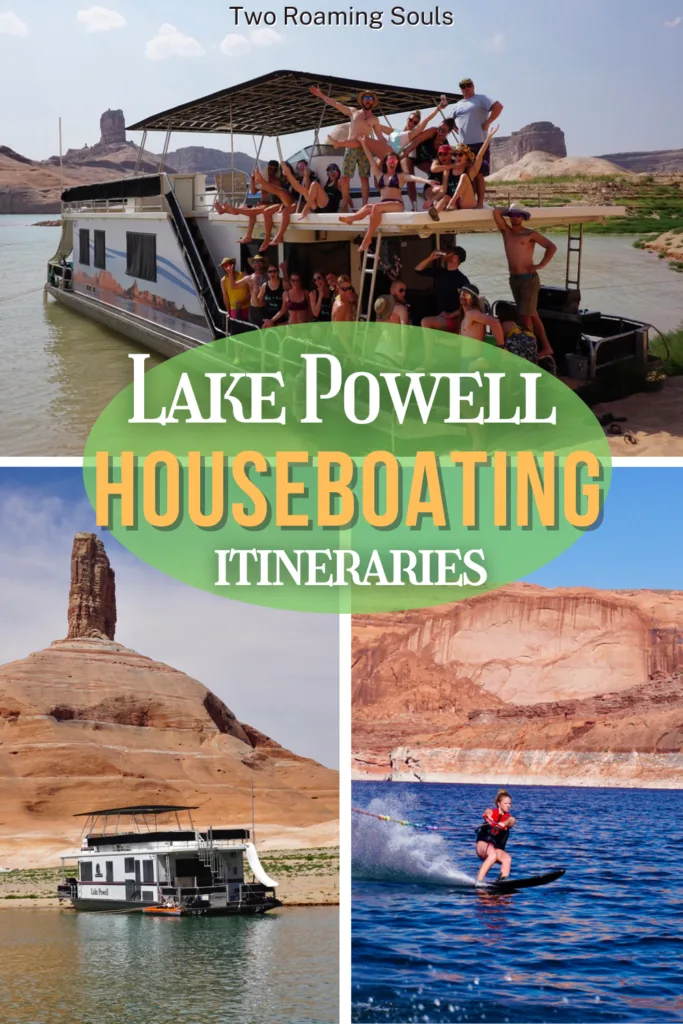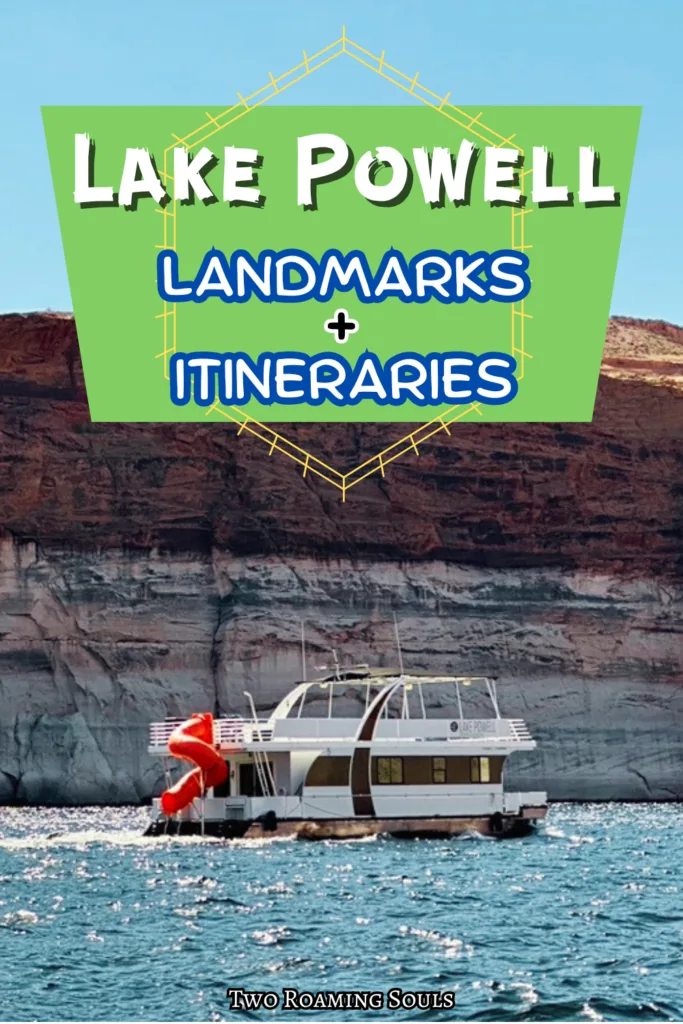If you are taking a houseboat trip on Lake Powell, how do you know where to go, or how to get around the lake? This massive lake in Utah and Arizona sets the scene for quite possibly the best place to houseboat in the world. But it takes preparation to plan your itinerary, navigate the lake safely, and anchor your houseboat at night.
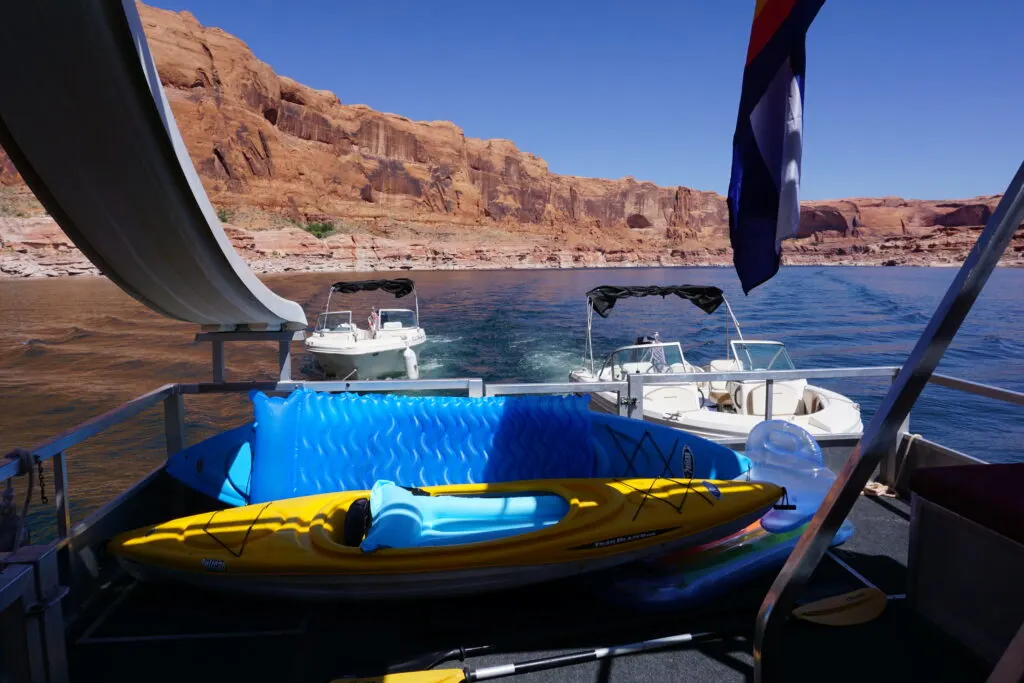
This is Part 3 of my Lake Powell Houseboat Trip Guide. This section is all about what to do once you finally depart from the marina.
I share some sample trip itineraries with the best places on Lake Powell. I also cover how to navigate your houseboat around the lake, how to anchor at night, and other helpful information.
If you missed the previous parts of this guide, it’s best to start from the beginning.
- Part 1: How To Plan A Lake Powell Houseboat Trip: Assemble Your Crew, Book A Houseboat Reservation
- Part 2: What To Bring On A Lake Powell Houseboat Trip & Preparing For Departure
This post may contain affiliate links. Disclosure policy.
Where To Go On Your Lake Powell Trip
So, you have finally left the marina with your houseboat, what should you do now?
There’s no right or wrong way to explore Lake Powell. But, personally my favorite scenery is near the middle of the lake. And it’s also where the lake is less crowded. So I usually structure our trip itinerary around getting to the middle of the lake.
This means boating north if you are leaving from Wahweap Marina, or heading south if you are starting at Bullfrog Marina.
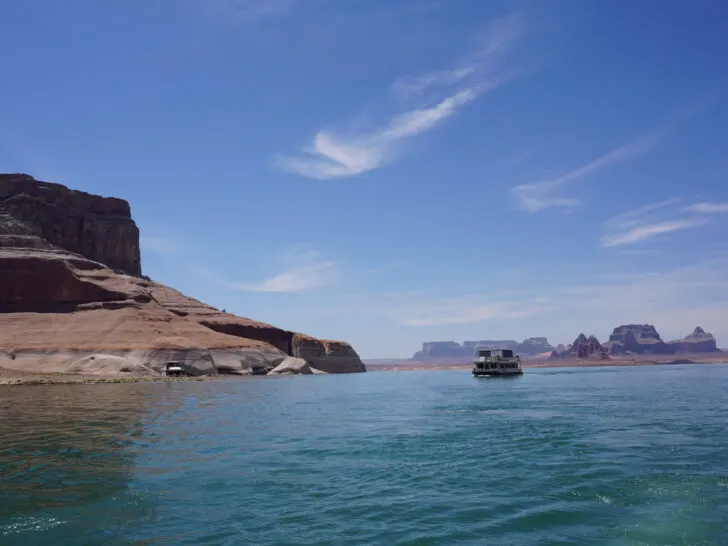
There are so many awesome places to go on Lake Powell it can be overwhelming to decide. But if you are leaving from Bullfrog Marina, you will probably stay in the northern half of the lake. And if you leave from Wahweap you will probably stay in the southern half of the lake.
Yes, technically you could make it to the other side of the lake, but you would burn a ton of gas and time. And I’m guessing you didn’t rent a houseboat because you want to spend most of your trip driving from one side of the lake to the other.
Or if you traverse the entire lake in a powerboat, you can do it a lot faster, but still, you would be burning a ton of gas. And you may not be able to fit your whole crew on your powerboat.
So we feel that the best Lake Powell Itinieraries strike a balance between exploration and relaxation. This involves setting realistic travel goals for each day.
If you are really serious about exploring the nooks and crannies of Lake Powell, I highly recommend getting a guidebook. There is simply too much information to cover in this blog post.
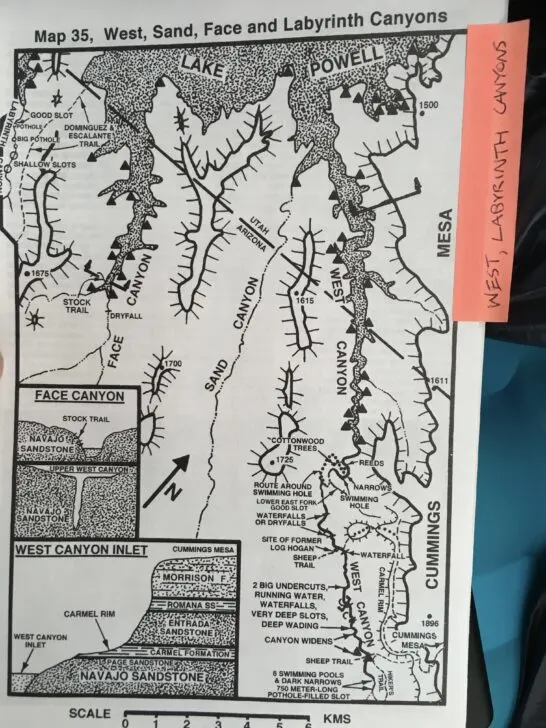
With a guidebook, you will have highly detailed information about everything there is to explore on Lake Powell. And importantly, you can still access the information even when you don’t have cell service during the trip.
But even without a guidebook, I can share some of our favorite places to explore.
Getting to those spots on the lake will somewhat dictate your itinerary. For example, if you want to get to Reflection Canyon from Bullfrog Marina, you likely won’t be able to make that voyage all in one day. So you will have to break up that distance into a few days of travel.
But you also need to keep your goals manageable, because you probably don’t want to spend too much of your vacation time just driving from A to B.
The three major factors for building the perfect Lake Powell Houseboat Trip itinerary are:
- Length of your trip
- What are you trying to see/do
- Available beaches to anchor
In our experience, the south half of the lake has many more suitable beaches than the north. So south Lake Powell trips seem to benefit from the flexibility of plenty of sandy beaches.
But if you are renting from Bullfrog Marina, your itinerary is influenced more by reaching the good beach spots.
If you want to see something that’s really far from the marina, you may want to structure your itinerary to break up the travel into multiple days.
Or if you have people showing up late or leaving early, you may want to structure your itinerary to stay closer to the marina.
It’s helpful to learn the major bays and side canyons to help get your bearings. The major bays and canyons on Lake Powell are (From South To North) Wahweap Bay, Navajo Canyon, Warm Creek Bay, Gunsight Bay, Padre Bay, Last Chance Bay, Rock Creek Bay, San Juan River, Escalante River, and Hall’s Creek Bay, Bullfrog Bay, and Good Hope Bay.
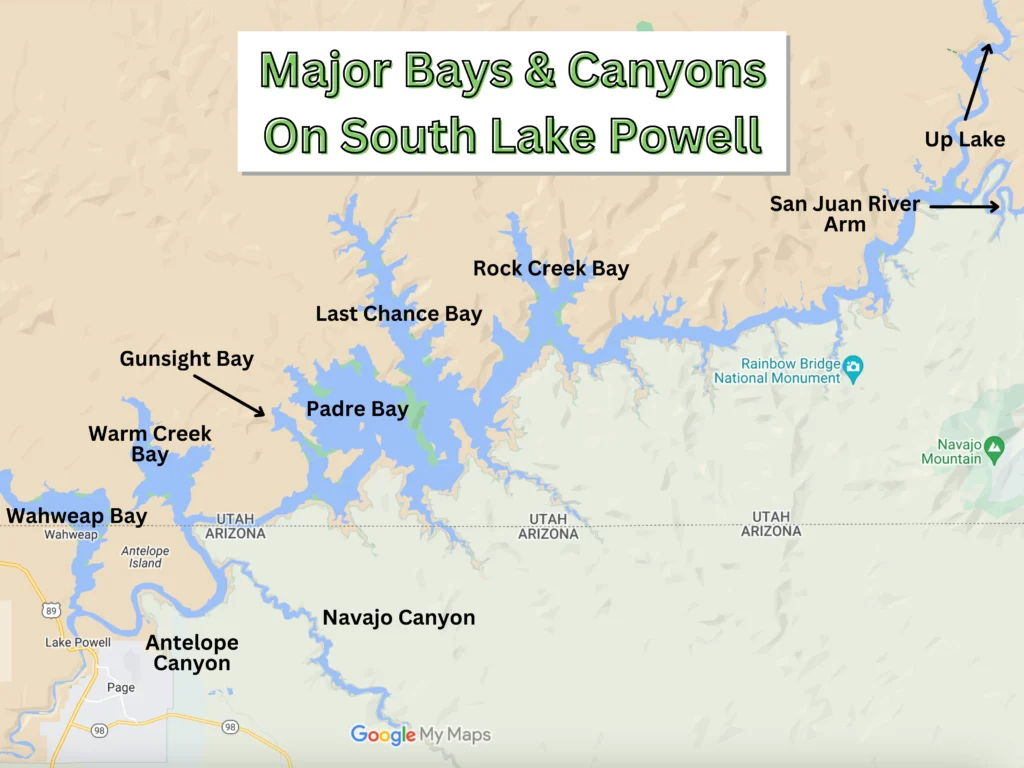
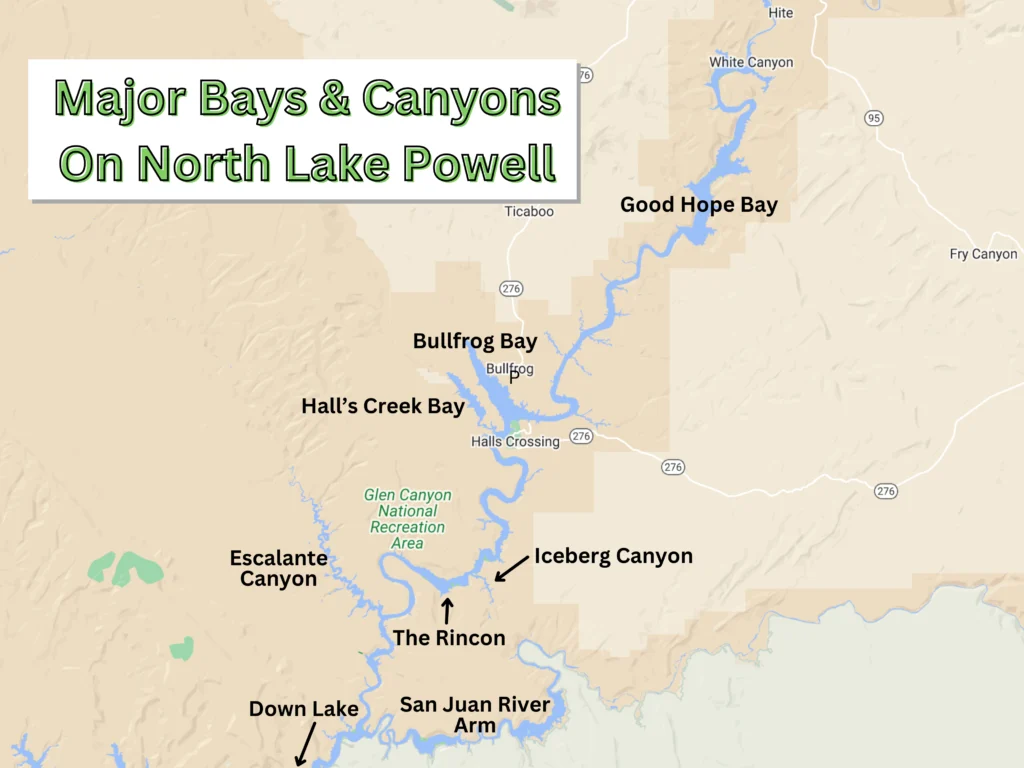
But when considering the size of Lake Powell, you only really need to familiarize yourself with the North or South side of the lake (depending on where you leave from).
Because logistically, most houseboat trips on Lake Powell just stick to one side of the lake.
Castle Rock Shortcut (AKA ‘The Cut’)
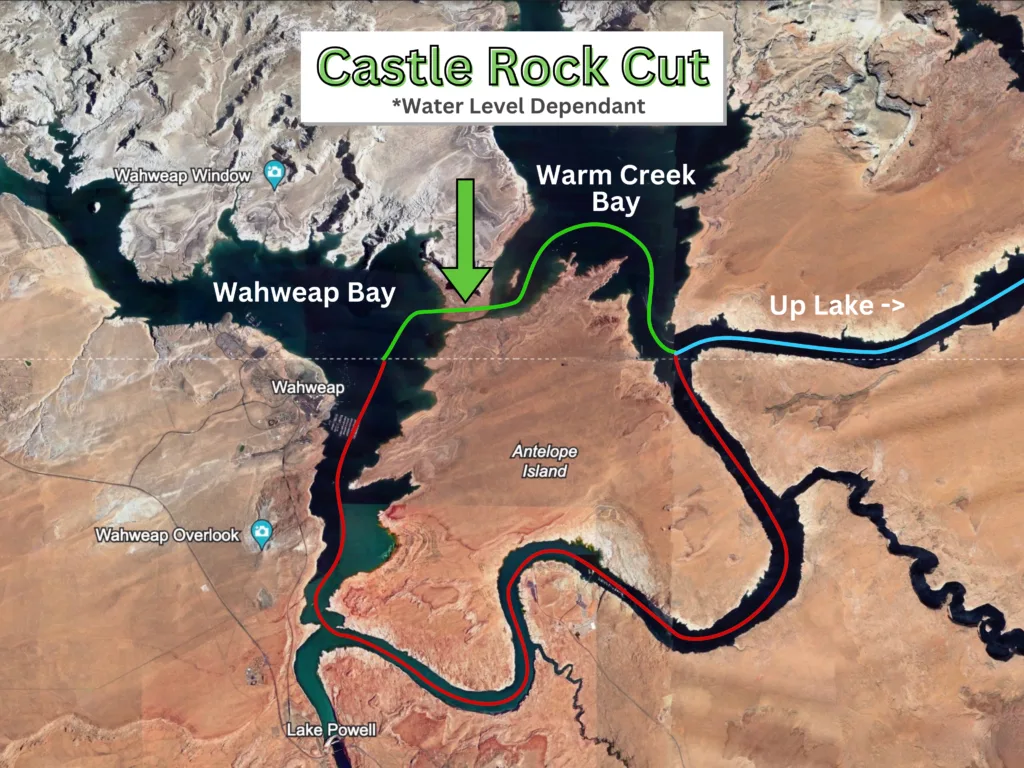
One important feature of Lake Powell’s geography is a small channel connecting Wahweap Bay and Warm Creek Bay. It’s called Castle Rock Cut or “The Cut” for short. When traveling north from Wahweap, it serves as a massive short cut to quickly moving north on the lake (and vice versa).
Without it, boats need to travel the long way around Antelope Island.
However, it is only open to boats when the water level is high enough. And with water in the west becoming more scarce, The Cut is open less frequently.
Even in the “good” water year of 2023, it was only open for one week in August. But in other recent years, it has not opened at all.
Still, it’s something worth asking about when you visit, because it can save about an hour of travel time.
Best Places To Go On Lake Powell
Listed South to North
Wahweap Bay (Lone Rock Beach)
Wahweap Bay is the southernmost bay on Lake Powell, and the location of Wahweap Marina. This wide open bay has plenty of space for boating and many sandy beaches. Surrounded by mostly white sandstone.
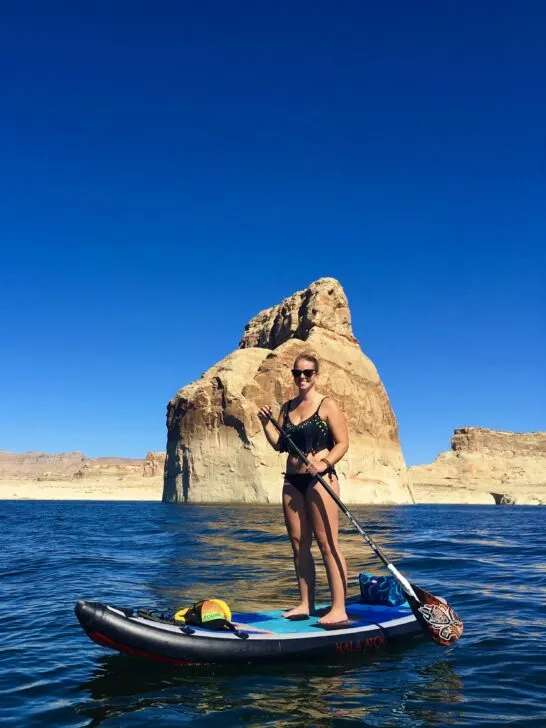
To the western end, you find Lone Rock Beach, named for the giant monolithic tower ‘Lone Rock’ in the middle of the bay.
Lone Rock Beach is one of the few campgrounds on the lake that allows car access. It’s a very popular area packed with RVs, trailers, campers, and more. For this reason, we typically avoid this area on our Lake Powell Houseboat Itineraries. But if you need to stay close to the Marina for whatever reason it’s a good place.
- Other Highlights (Ice Cream Slot Canyon, Castle Rock)
Glen Canyon Dam
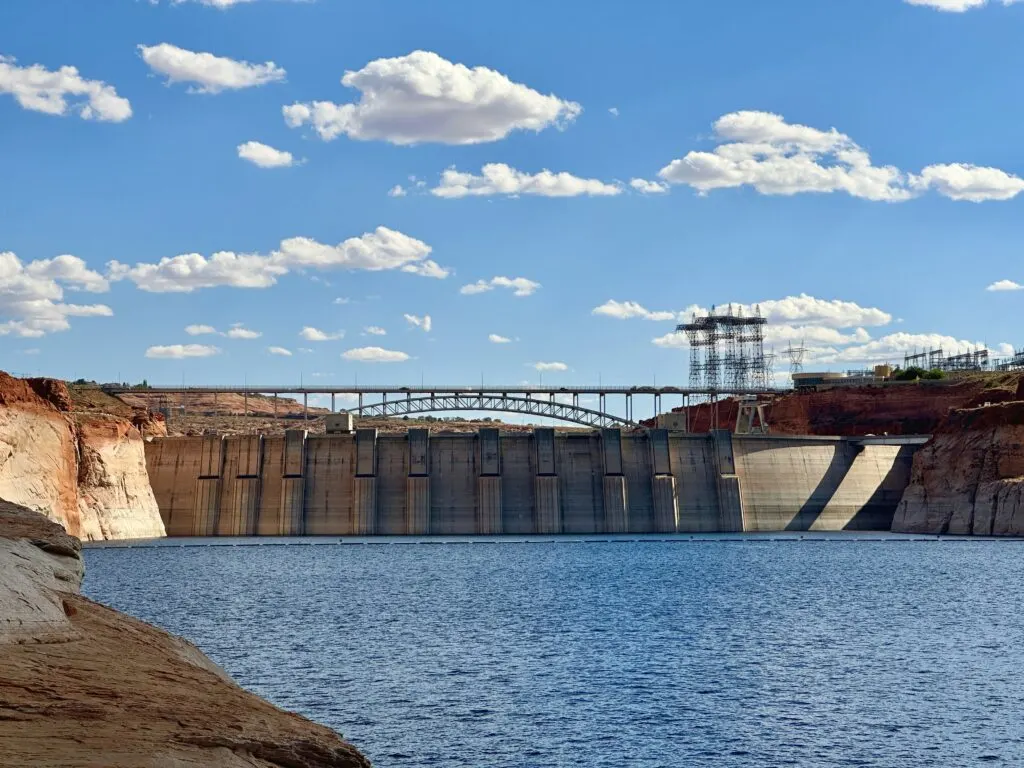
Glen Canyon Dam is the hydrological dam built in the 1960s that created Lake Powell (actually a reservoir). If you are boating around Antelope Island, it’s only a short detour to visit the Glen Canyon Dam. Though, personally, I think it’s more impressive to visit the dam from the land-based overlooks like the Carl Hayden Visitor Center and Glen Canyon Dam Overlook.
Antelope Canyon
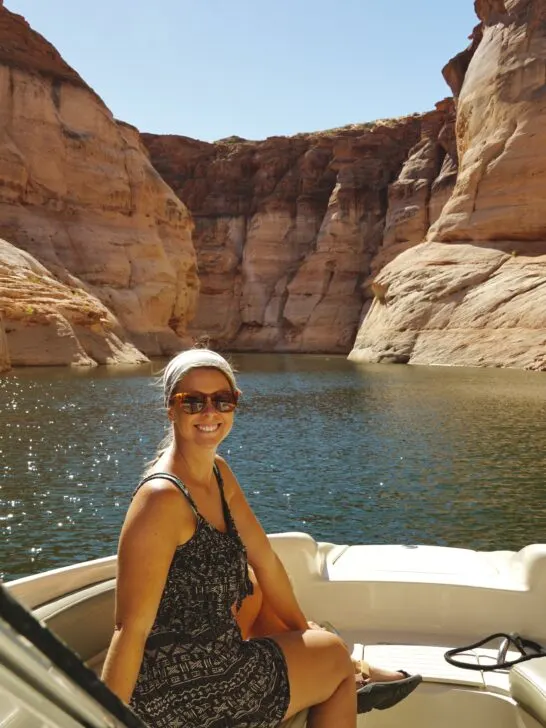
Antelope Canyon is probably one of the most famous landmarks in all of the Southwest. The canyons narrow into a wispy sandstone slot canyon with striking textures.
However, the most famous parts are restricted to paid tours that you access from land. Still, many boaters explore the lowest sections of Antelope Canyon, which still has some impressive narrow canyon scenery. You can hike up into it once the water ends.
Warm Creek Bay
Another one of Lake Powell’s largest bays is Warm Creek Bay. There’s tons of open space for boating and many large sandy beaches. There are some 4×4 roads with access to the lakefront here.
The landscape is still mostly white sandstone with minimal canyons and cliffs.
Gunsight Bay
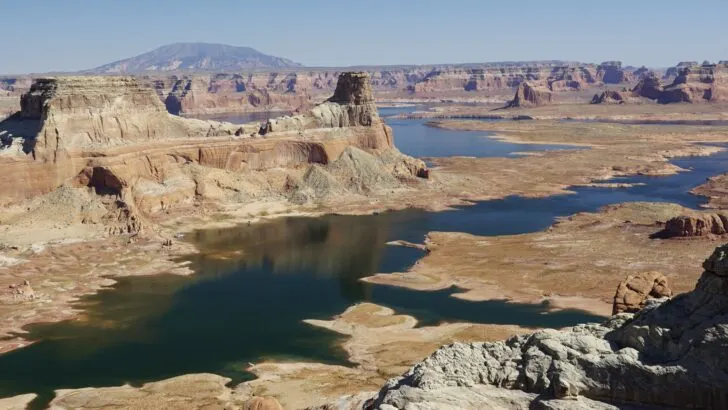
This is where you begin to reach the quintessential Lake Powell scenery. Loads of red sandstone cliffs, buttes, and mesas. The namesake of this bay is Gunsight Butte, a rock formation that looks like the sights on a rifle.
The bay is a little bit more narrow than other big bays in south Lake Powell (especially when water levels are low). But there’s still a decent amount of sandy beaches and coves to anchor.
- Other Highlights (Labyrinth Canyon across the main channel is one of the better slot canyons to explore.)
Padre Bay
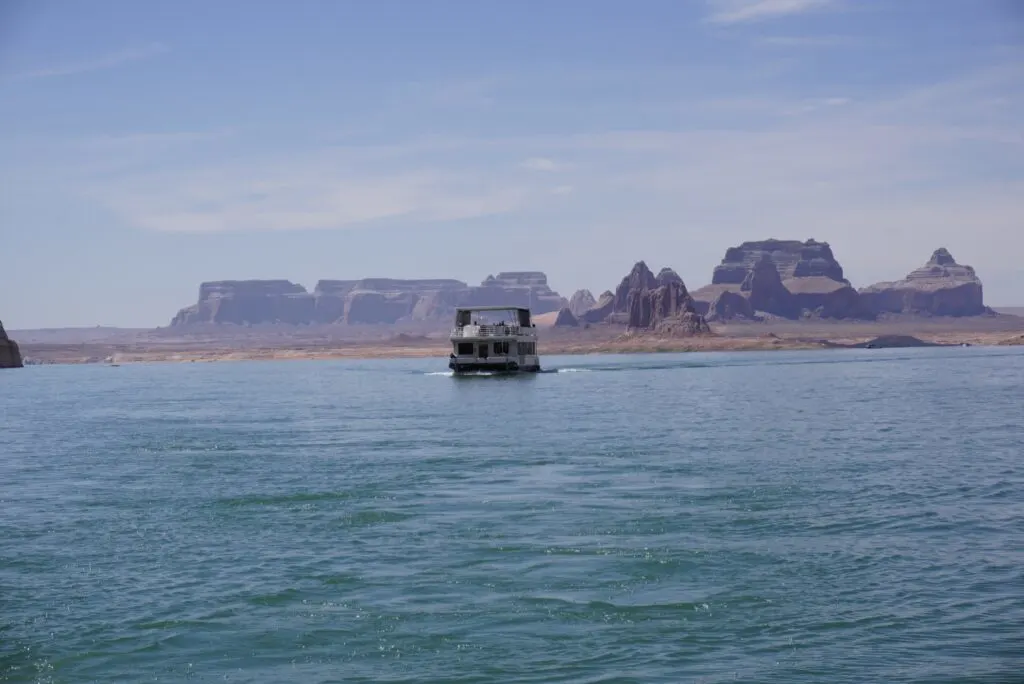
Padre Bay has always been my favorite location to anchor at Lake Powell. This massive bay is surrounded by amazing red rock scenery, and plenty far from civilization that it never feels crowded.
It’s a several-hour drive from Wahweap Marina, and it’s usually what we aim for on our first day.
On the north side, there are several coves that offer great beaches to tuck into.
- Other Highlights (Cookie Jar Rock, Toilet Bowl, Face Canyon across the main channel)
Last Chance Bay
A long canyon with impressive tall walls on either side and tons of “fingers”. Not many big beaches, but still some smaller sandy coves that you can anchor.
West Canyon
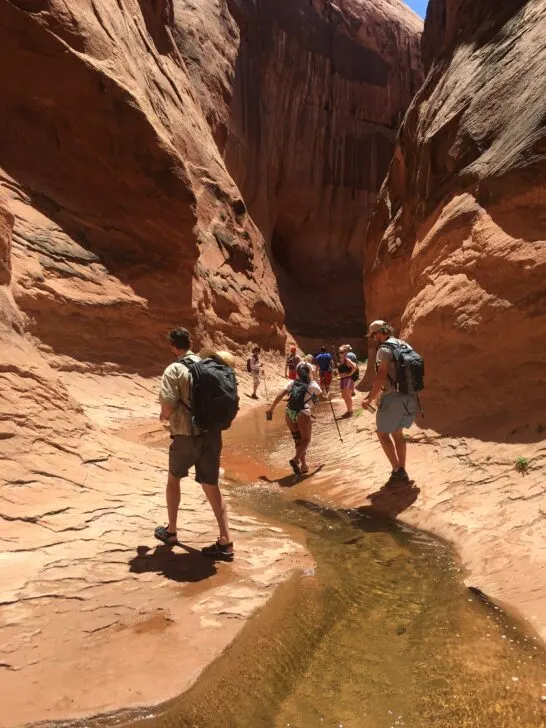
Our absolute favorite slot canyon to explore on Lake Powell. It’s not ideal to take houseboats in, but smaller boats are perfect to take deep into the canyon.
If you are up for it, a several-mile hike leads to one of the best slot canyons in all of Lake Powell. Makes an amazing all-day adventure.
Rainbow Bridge National Monument
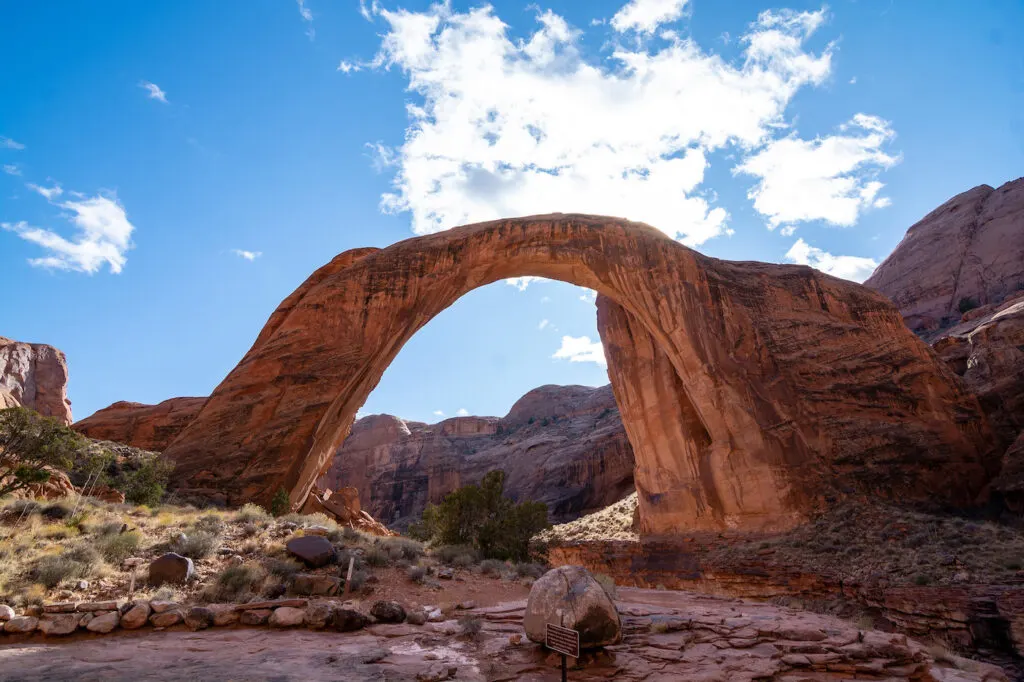
Rainbow Bridge is one of the world’s largest natural arches. It’s undoubtedly one of the most impressive landmarks at Lake Powell.
In the past boaters could drive right up to the arch. But with current water levels, it requires about a 1-mile hike in to visit.
I consider Rainbow Bridge the unofficial halfway point between Wahweap Marina and Bullfrog Marina. For logistical reasons, I consider it the maximum distance you would consider traveling with a houseboat before turning around.
This is about as far North as I would recommend going on a South Lake Powell trip. And conversely, as far South as I would go for a North Lake Powell trip. Even on a 7-day itinerary, it would still be lots of time spent motoring your houseboat to get here.
Ideally, you anchor the houseboat somewhere within striking distance and take the faster powerboats or jetskis the rest of the way.
Reflection Canyon
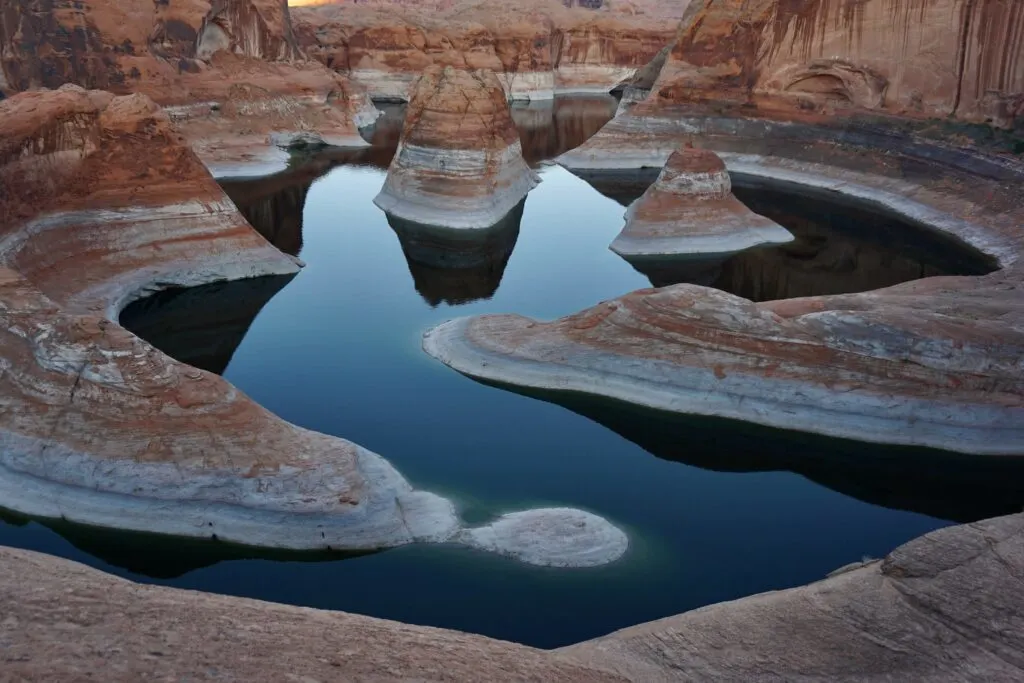
One of the most photographed locations on Lake Powell is Reflection Canyon. However, the famous view is actually inaccessible from the lake. And the view you get from visiting via boat is not really comparable. I want to make that very clear, because it’s a far distance to travel to find out that you are not going to see the famous ‘Reflection Canyon’ view.
Getting to this view requires a grueling 18-mile backpacking trip that’s an entire adventure on its own. (Read our guide to backpacking to Reflection Canyon).
Hole-In-The-Rock
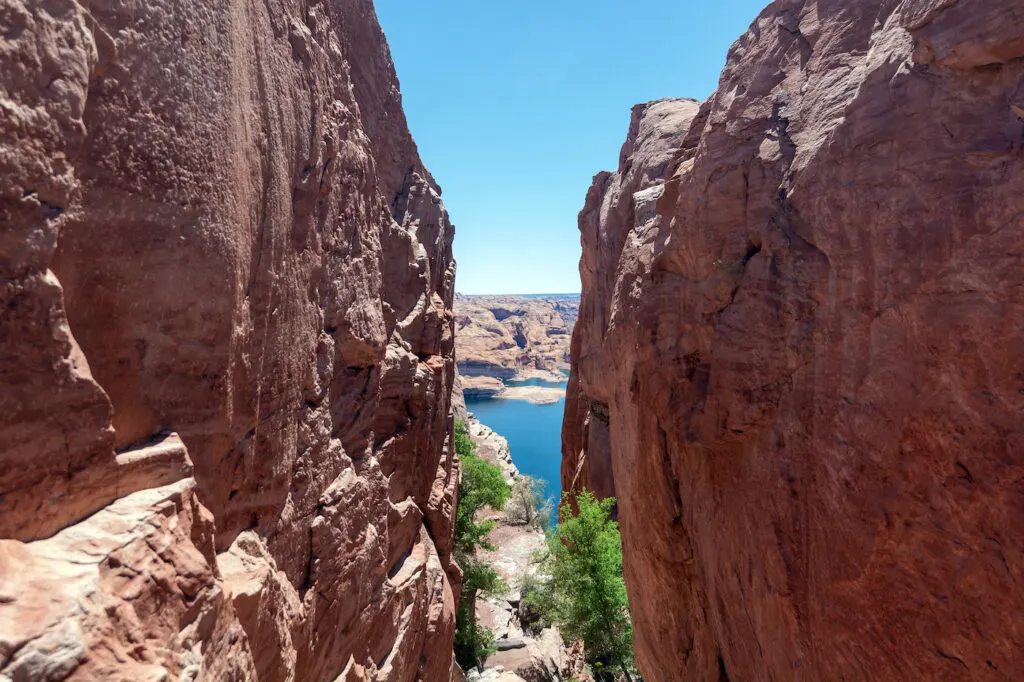
A historic location where early pioneers would cross the Colorado River. This narrow crack in the canyon rim is surprisingly one of the best places to cross mid-lake.
Fit and motivated individuals can hike the slot up to the rim for an incredible view of Lake Powell and Navajo Mountain in the background.
Escalante River Arm
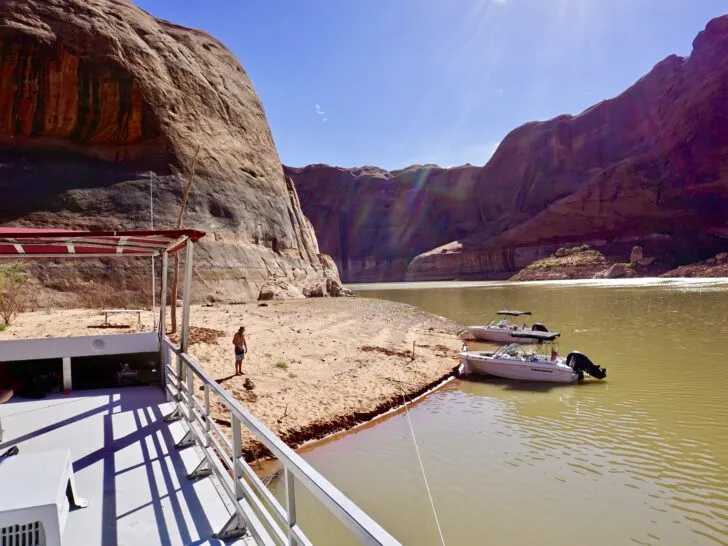
One of the longest tributary canyons of Lake Powell. There are tall canyon walls on both sides and plenty of side canyons to explore. But, due to the geography, there are not many big sandy beaches to anchor a houseboat.
- Other Highlights (La Gorce Arch, Gregory Natural Bridge)
The Rincon
A dried-up bend in the river called The Rincon. This is one of the few places in North Lake Powell that reliably has long stretches of sandy beach. But being in the main channel, beware of wind and waves.
Iceberg Canyon
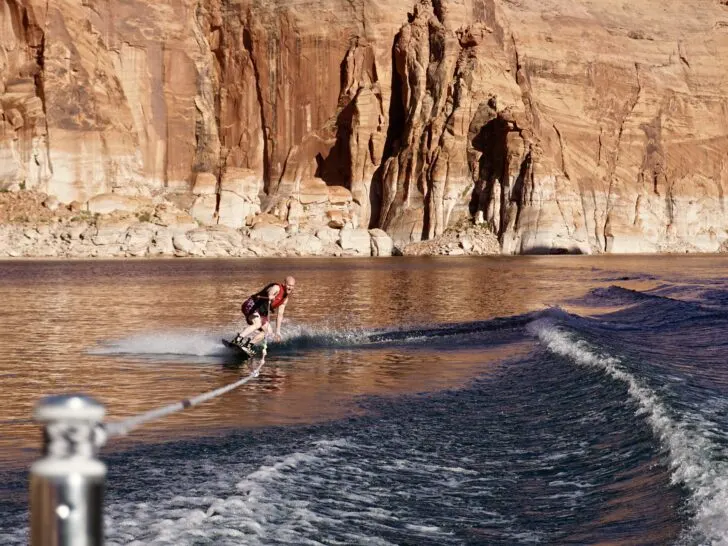
One of the more visually striking side canyons in North Lake Powell. Narrow with tall walls and several fingers to explore. Just a few potential anchor sites.
Halls Creek Bay
The second largest bay on North Lake Powell. There are plenty of sandy beaches and wide open spaces for boating.
Bullfrog Bay
The largest bay on North Lake Powell, and the location of Bullfrog Marina. Plenty of sandy beaches.
North Of Bullfrog
If you explore north of Bullfrog Bay, you can find even more interesting landmarks like Moqui Canyon, Forgotten Canyon, Defiance House Ruins, Good Hope Bay, and more.
Lake Powell Itineraries
Here are a couple of good sample Lake Powell Trip Itineraries to follow.
(Note that anchor locations are not precise. The water level is constantly changing what is or is not available).
5-Day Wahweap Itinerary (Our personal favorite)
Day 1: Houseboat up to Padre Bay to anchor
- Explore the “Toilet Bowl”
Day 2: Houseboat to Friendship Cove to anchor
Day 3: Stay put
- Explore West Canyon with small boats (optional slot canyon hike)
Day 4: Houseboat to Gunsight Bay to anchor
- Explore Labyrinth Canyon with small boats
Day 5: Drive back to the Marina
7-Day Wahweap Itinerary
Day 1: Houseboat To Gunsight Butte to anchor
- Explore Labyrinth Canyon with small boats (optional slot canyon hike)
Day 2: Houseboat to Rock Creek Bay to anchor
Day 3: Stay put
- Take powerboats to see Rainbow Bridge Natl. Monument
Day 4: Stay put
- Day of games on the beach
Day 5: Move houseboat to Padre Bay
- Explore Toilet Bowl
Day 6: Stay put, free day
Day 7: Houseboat back to the Wahweap Marina
5-Day Bullfrog Itinerary
Day 1: Houseboat to the Rincon to anchor
- Explore Iceberg Canyon with small boats
Day 2: Houseboat to Escalante Canyon to anchor
- Explore Gregory Natural Bridge or La Gorce Arch
Day 3: Stay put
- Hike into Willow Canyon
Day 4: Houseboat to the Rincon to anchor
- Explore Bowns Canyon with small boats and on foot.
Day 5: Houseboat back to Bullfrog Marina
7-Day Bullfrog Itinerary
Day 1: Boat to the Rincon to anchor
- Explore Iceberg Canyon with small boats
Day 2: Boat to Hole-In-The-Rock to anchor
- Climb up to the rim if you are feeling motivated.
Day 3: Boat to San Juan River Confluence to anchor
Day 4: Explore Reflection Canyon with small boats
Day 5: Stay put
- Take small boats to Rainbow Bridge National Monument
Day 6: Houseboat to Escalante River Arm to anchor
- Visit La Gorce Arch
Day 7: Houseboat back to Bullfrog Marina
Use these Lake Powell Itineraries to pack a bunch of amazing destinations and adventures into your houseboat trip.
Feel free to modify them to fit your schedule and interests.
Boating Around Lake Powell
But before you can go anywhere, you need to know how to navigate around Lake Powell.
If you only rented a houseboat, then it’s pretty simple. You can just worry about steering your houseboat.
Really, they are operated just like any other boat, just much bigger (and with a few more blind spots). That’s why it’s a good idea to always have your crew members help you keep an eye out for other boats or potential hazards.
Houseboating With Additional Boats
But most houseboat rentals on Lake Powell also include some fun add-ons like powerboats and jet skis. This makes it a little bit more complicated to motor around the lake.
If you have power boats or jet skis, you should tow them behind your houseboat when not in use.
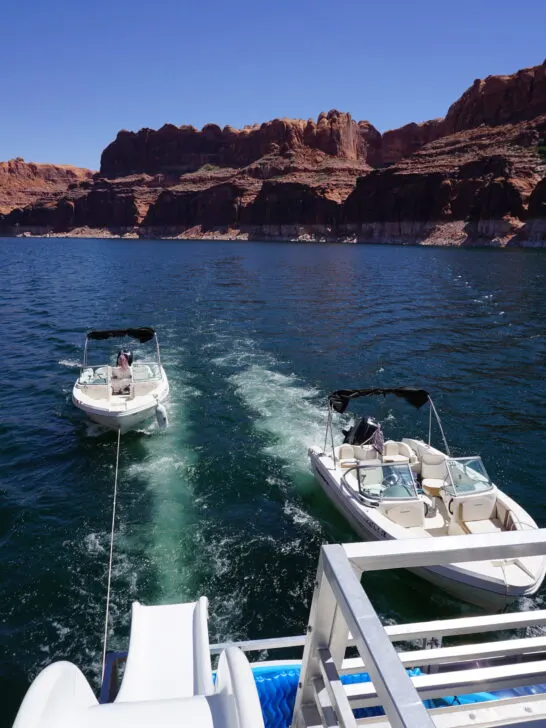
After your safe and smooth departure from the Marina, you can radio to your other boat(s). Rendevous once you’re outside the marina’s breakwater (it’s like a giant line of floating tires that protect that marina from waves.
Put the houseboat into neutral and let it coast to a stop, then turn off the engines. Next, radio your smaller boat(s) to approach the houseboat from the rear. Have a crew member or two on the back of your houseboat to receive the other boat(s). There is a cleat on each corner of the back of the houseboat.
Tie your smaller vessel(s) to the houseboat, leaving about 10-30 feet of rope between your houseboat and smaller boat(s). If you have multiple add-ons, you need to stagger them with different rope lengths so they don’t hit each other.
Basic Boating Knots You Should Know
If you’re not familiar with some basic nautical knots, it’s a good idea to review the two big ones before your trip: the bowline and the cleat hitch.
The bowline knot is used to attach a rope to the front of your powerboat. This knot will likely already be tied for you, but it’s still a good idea to know how to tie one. It’s the best way to create a loop that’s easy to un-tie no matter how much tension is put on it.
Then you will use a cleat hitch on the other end of the rope to attach it to your houseboat. It’s good to review how to tie a cleat hitch, because you don’t want your ropes coming loose. (You will also use this for your anchor lines, described in detail later).
Navigating Lake Powell
Getting around Lake Powell safely and without getting lost can be daunting, even for seasoned boaters.
Luckily, there are mile-marker buoys along the main channel of the lake that are helpful for navigation. The main channel is essentially the former path of the Colorado River before it was dammed to create the reservoir. It runs generally from the northeast to the southwest.
In some places, the main channel is easy to follow through an obvious canyon with towering sandstone walls on either side. But other times it follows a less clear path through the wide open bays. This is when the buoys are much more essential to staying “on track”.
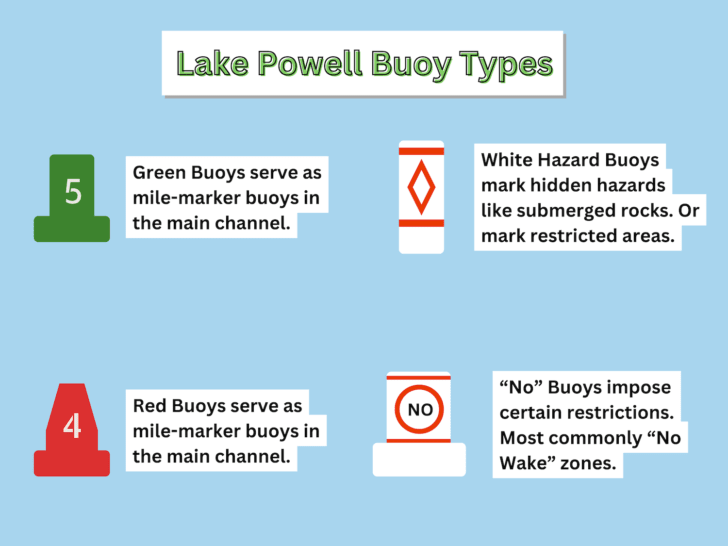
The buoys in the main channel form the easy nautical “rules of the road”. These green and red mile-marker buoys are numbered with their approximate distance (in miles) from the Glen Canyon Dam (the southernmost tip of the lake).
But depending on the water level, there are many potential “shortcuts” which you can use with caution.
For the most part, the buoys are close enough together that you’ll see the next one shortly after passing one. When you pass a buoy, check what number is on it, and then find the corresponding buoy on your map to figure out where you are. (This is when binoculars are extremely helpful).
Following the buoys will help you stay in the main channel, where you generally don’t have to worry about the lake depth.
To use the buoys for navigation, when traveling north (or upstream) keep the Red buoys on your right and green on your left. Or commonly remembered as “Red Right Returning”, as though you are returning to where the Colorado River enters the lake.
Conversely, if you are traveling south on the lake (downstream), you keep the red buoys on your left and green buoys on your right.
Within the space between the buoys, try to stay to the right side of the channel (just like driving in the US). Using this method creates two loosely defined “lanes”, allowing boats to travel in opposite directions without issues.
The two other buoy types to watch out for are Hazard Buoys and “No” Buoys. Hazard “stick” buoys mark things like underwater rocks or other potential hazards. “No” buoys are most commonly found as “No Wake” buoys surrounding marinas and in narrow or heavily trafficked canyons.
Exploring Side Canyons and Bays
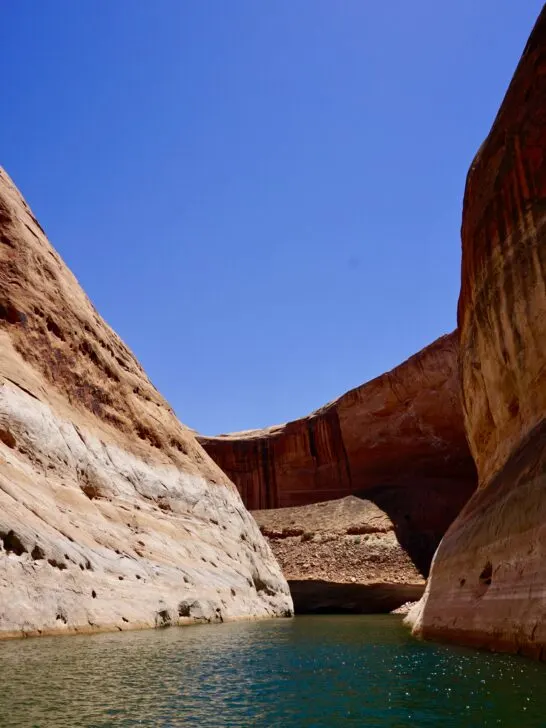
But I’m sure you didn’t come all the way to Lake Powell just to stay in the main channel. When you’re ready to explore beyond the main channel, you can use the mile-marked buoys to locate Lake Powell’s many side canyons and bays.
However, once you leave the main canyon you will no longer have the convenience of the mile-marked buoys to guide you. From this point on, you will need to be able to retrace your steps to get back to the main canyon.
And there is always the possibility of unmarked obstacles outside the main channel. You need to be vigilant of submerged rocks, shallow areas, and more. The water level of Lake Powell is constantly changing, so what might have been a perfect beach in June might not even exist in August.
Some canyons are plenty big enough to explore with your houseboat. But in our experience, it’s always more fun (and practical) to explore canyons in a powerboat, jetski, kayak, or paddleboard. These smaller boats can take you all the way, basically until the water ends.
Be cautious around blind turns when traveling in narrow canyons. Sadly, there are always some overzealous folks who drive too fast around blind corners.
How To Beach The Houseboat At Night
Every night, you need to have your houseboat anchored to a beach. You should leave enough time to find a suitable beach and set the anchors. I would recommend reserving at least an hour for this process.
Driving boats after dark is prohibited so you want to give yourself ample time to find a good spot to beach.
If you have powerboats or jet skis, you can use them to quickly scout good beaches to anchor.
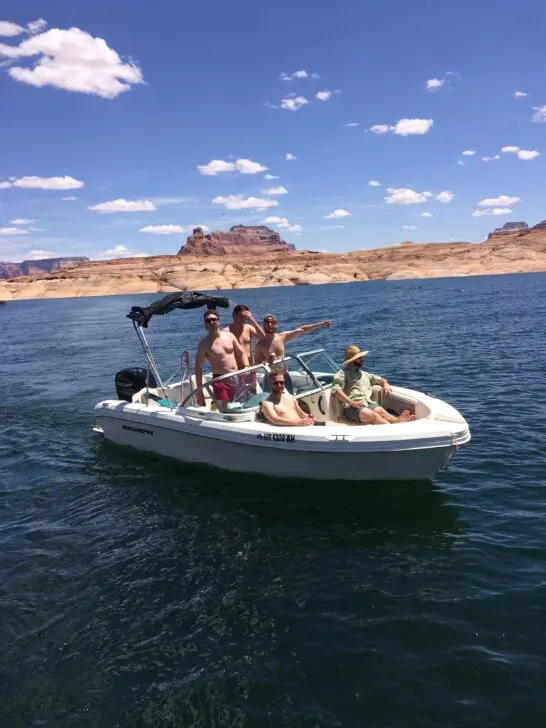
If you only have a houseboat you will have to carefully scout beaches with your houseboat while being extra careful of shallow areas.
If you are scouting with smaller boats, use the radio to communicate with the houseboat and tell them where to go.
Depending on where you are on the lake, finding a good beach can be really easy or sometimes very challenging. There are long sections of Lake Powell that have rock walls straight up out of the water on both sides. But there are also lots of expansive bays that have long stretches of sandy beach that could fit 10 or more houseboats side by side.
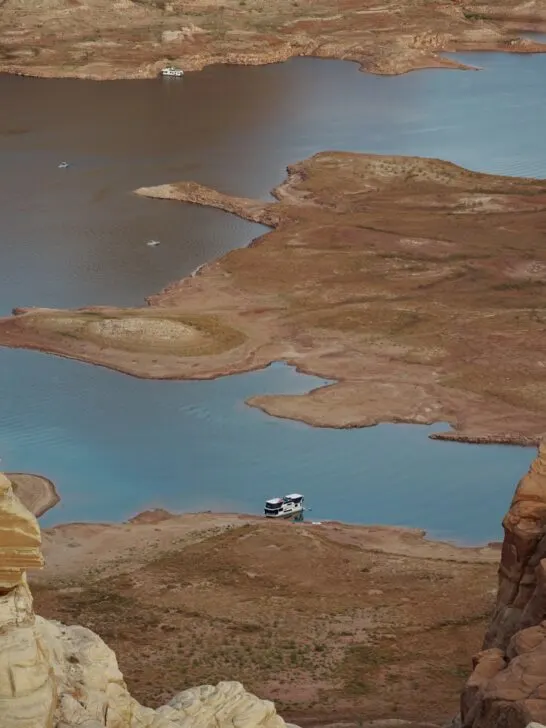
And in between those two extremes, there are loads of small coves or short beaches that are perfect for just one or a couple of houseboats.
The ideal beach will have soft sand, a reasonably flat area above the waterline, and a pretty steep drop-off under the waterline.
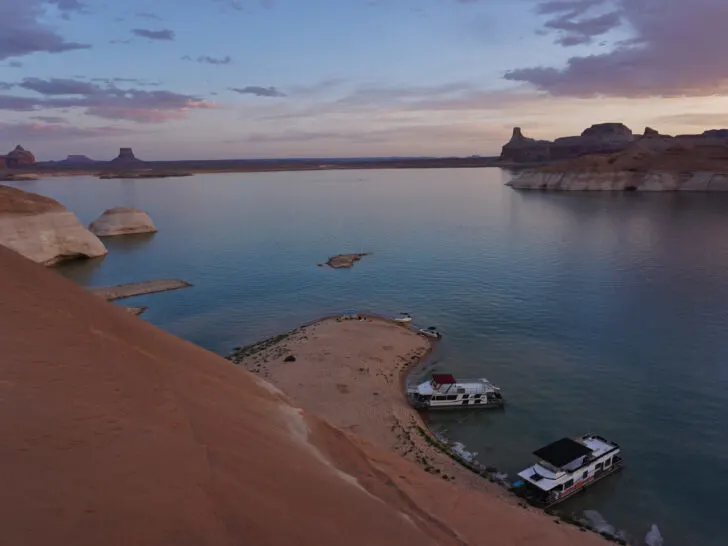
A flat beach is good for games and campfires, and a steep drop-off into the water will ensure that your houseboat engines have plenty of clearance underwater. And also if the water is deep enough behind your houseboat you can use the water slide and jump/dive off the back.
Long stretches of sandy beach are by far the easiest place to anchor for the night, but it’s common that you will be sharing the beach with other groups.
I much prefer the smaller, more private beaches/coves. That way nobody will anchor next to you, so you don’t have to worry about bothering your neighbors, or vice versa.
Having a soft sandy beach is the best scenario because then you don’t have to worry about damage to your boats and you also have a great place for games and campfires.
You also want to be sure there is shoreline at least the length of your boat on either side. The reason for this becomes clear when we get to the proper anchoring technique.
Anchoring your Houseboat
Anchoring is almost certainly the most physically demanding part of a Lake Powell Houseboat Trip. Specifically, digging holes for the anchors and putting tension on the anchor lines (ropes).
The two biggest factors that impact anchoring are the size of your houseboat and the wind speeds. The bigger your boat and the rougher the weather, the more secure your anchors must be.
If you have other powerboats or jet skis, I prefer to beach them on shore about 100-300 feet away from where the houseboat will go. Giving you plenty of room to maneuver, and leaving everyone available to help with anchoring.
Once the houseboat is just offshore from the spot you picked, make sure several of your crew members on the houseboat are ready to deploy the anchors. Have your houseboat captain drive the houseboat slowly straight into the beach.
Once your houseboat has come to a stop against the shore, keep the engines running at a very low speed. This will keep the houseboat pinned up against the beach while your crew secures the anchors.
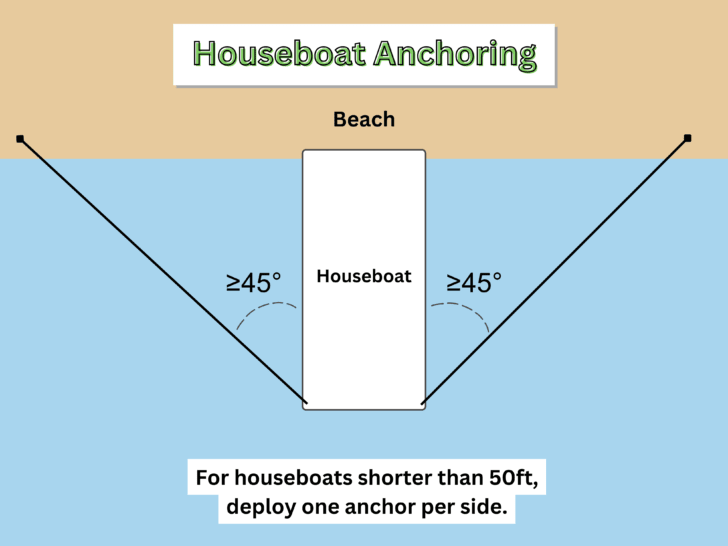
Using the shovel provided on the boat, dig a 2-3 foot deep hole for each anchor. You want the anchor lines to be at a 45-degree angle from the cleats on the back (stern) of the boat. And 45 degrees is the minimum!!! You can honestly go up to 90 degrees if the beach allows.
Too many times I’ve seen an anchor set at around 30 degrees, then the wind starts blowing, the tail of the boat pivots, and instantly it’s down to like 25 degrees or less, and then the boat is in danger of going sideways against the shore.
No matter how many times we do this trip, people really struggle with the concept of the 45-degree angle. And it really matters. You lose a lot of leverage quickly when the angle decreases.
For boats 50 feet and above you are encouraged to set two anchors on each side. One at 45 degrees, and another between 45 and 90 degrees.
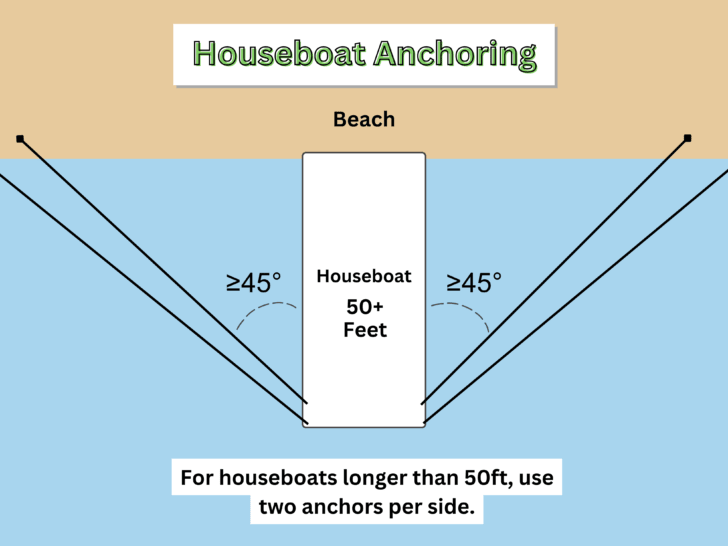
Once the anchors are buried in the sand, tie off the other end of the rope to the cleats on the back of the boat. It really takes about 2 or 3 people to put enough tension on the ropes and cleat them.
It is important to have high tension on the rope. Because slack in the rope can cause your houseboat to shift from wind and/or waves. And this swinging motion creates extra force on your anchors and can dislodge even a properly seated anchor.
So make sure the anchor lines are taught on both sides.
The shape of the shoreline also matters. You generally want a straight or slightly concave shoreline for easy anchoring.
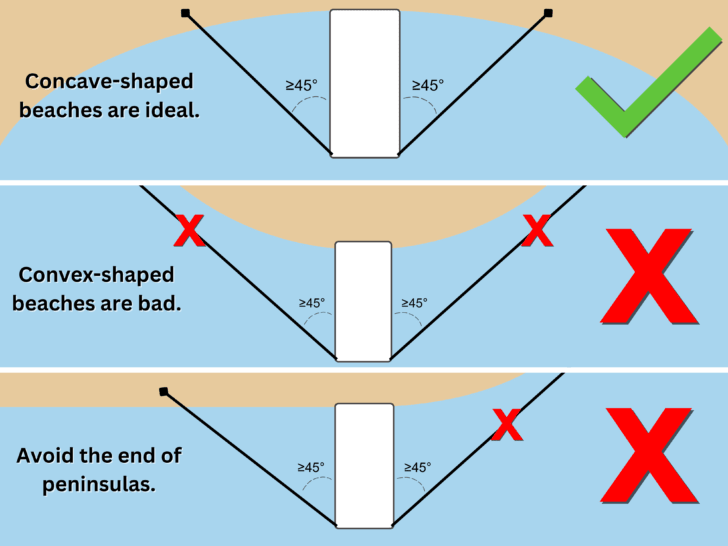
Compensating For Water Level Changes
The water level in Lake Powell is constantly changing, so you need to account for that with your anchor ropes. If you stay in the same spot for multiple days, be aware of how that affects your anchor ropes.
Generally, in the spring the water level is rising so you may need to re-tighten your anchor lines daily to keep them tight. And you want to ensure that your anchor placement wont be underwater a few days after placing them.
In the fall the water level is decreasing. So you may want to loosen your anchor ropes slightly and maybe even back up your houseboat to ensure it doesn’t get too beached.
What Can Go Wrong Without Propper Anchoring
One night we were beached in the main channel and only dropped two anchors. The wind changed direction almost 180 degrees and picked up significantly right after everyone went to sleep. I could feel the houseboat moving too much and had a gut feeling that something was wrong. I went onto the beach to investigate.
Large waves started rolling across the entire width of the lake and coupled with high winds, they started pulling one anchor loose. The houseboat was rotating very quickly towards the beach.
I ran into the houseboat to wake people up to help. It took 4 to 5 of us pulling on the windward anchor to bring the houseboat back perpendicular to the beach. If the boat had washed up parallel to the beach, the propellers would likely have been jammed into the sand and possibly damaged.
The moral of the story, it’s better to be safe than sorry, and just because it’s calm when you go to sleep doesn’t mean that the weather will stay that way. Don’t let calm weather lull you into a sense of false confidence.
Securing Your Powerboats or Jetskis
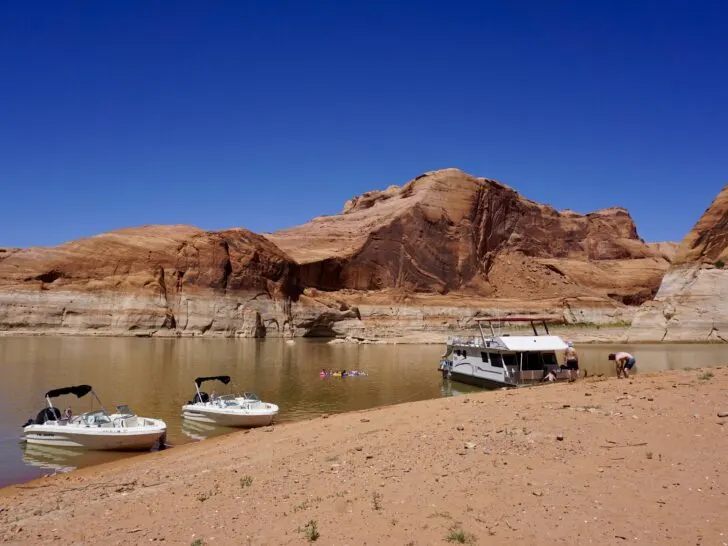
Now that your houseboat is secure, move onto securing any other powerboats and jet skis you have. One of my other main complaints about Lake Powell Resorts & Marinas is that they don’t provide you with anchors for the powerboats or jet skis.
Their response is “There’s usually a tree or rock that you can tie it to.” I don’t know which Lake Powell they are on, but there are basically no trees.
And finding a rock that’s light enough to move, but substantial enough to use as an anchor can be tricky.
This anchor issue doesn’t ruin the trip by any stretch, but it is a mild inconvenience. The best strategy is to find a rock that is about the size of a big watermelon. Then tie the bow line (rope attached to the front of the boat) around the middle of the rock, then bury it under about 1 foot of sand.
This might be overkill, but it will give you peace of mind even if the weather gets rough.
Anchoring On Rocky Shoreline (Not Recommended)
In the rare case that you can’t find a sandy beach and might have to settle for something a little rocky. This is not ideal because it will be harder to dig anchor holes and your boats could more easily be damaged.
Instead of digging holes for anchors, you can tie off to really large rocks or trees. But in our experience, you would have to get pretty lucky to find rocks or trees that are up to the task.
We have never had to anchor in a rocky place, but have seen other people anchored in rocky coves before.
Luckily, the majority of the rock around Lake Powell is sandstone, which is not a very hard variety of rock. But still, sandstone could do damage to your boats with enough force.
If you have to anchor your boats on slickrock, it’s best to be in a small protected cove or inlet. This will reduce the amount of wind and waves moving your boats throughout the night.
I would never anchor in a rocky area if it’s in a large bay or high-traffic area of the lake. There’s a high likelihood of waves bashing your boats against the rocks over and over. If you find a protected cove, it should keep the water around your boats calm, and greatly decrease the chance of problems.
Anchoring Near Tall Canyon Walls
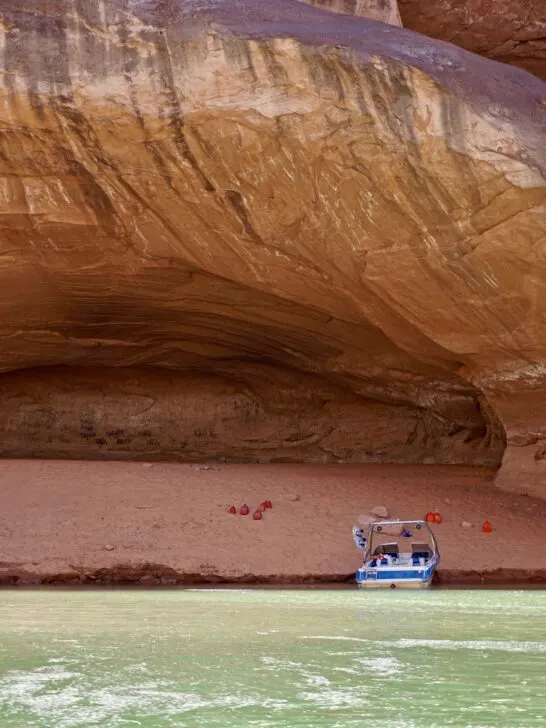
There are a couple of considerations when anchoring near tall canyon walls. In windy weather, canyons can provide a bit of cover from the wind and waves.
Secondly, canyon walls can provide some shade from the sun. You can potentially use that to your advantage. For example, anchoring beneath a wall to the west can provide some early relief some abusing afternoon sun/heat.
However, canyon walls can also pose some safety risks when it rains. Heavy rains can cause flash flooding that creates gushing waterfalls that pour over canyon rims. Beware of this danger if rain is in the forecast.
How Often Should You Move Your Houseboat?
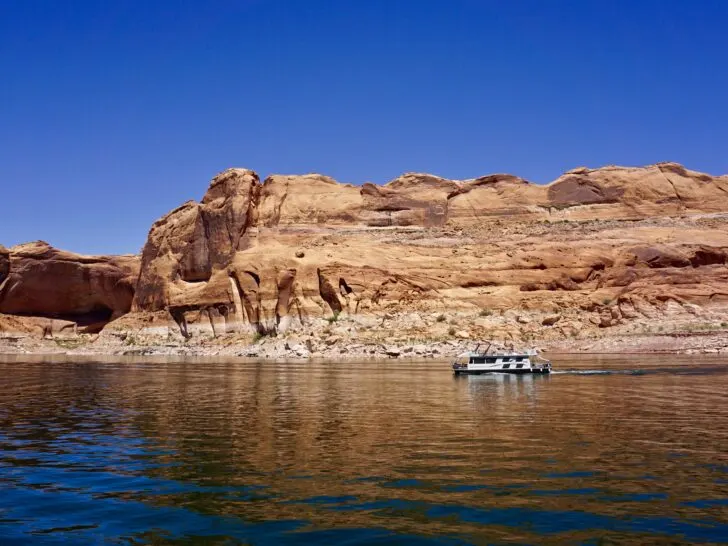
How often you decide to move your houseboat is totally up to you.
Some people will choose to park their houseboat on day one and not move until the last day of their vacation. Others may choose to move the houseboat every day, or somewhere in between.
You can decide if it’s worth it to move to a new beach every day or spend a couple of nights in one spot.
The amount of time it takes to move the houseboat is pretty significant.
Consider the time it takes to pack up everything you set up on the beach, dig up the anchors, drive to a new area, scout a new spot, beach the houseboat, and lastly set anchors again.
The sheer length of that sentence should give you an idea of the many hours the whole process takes.
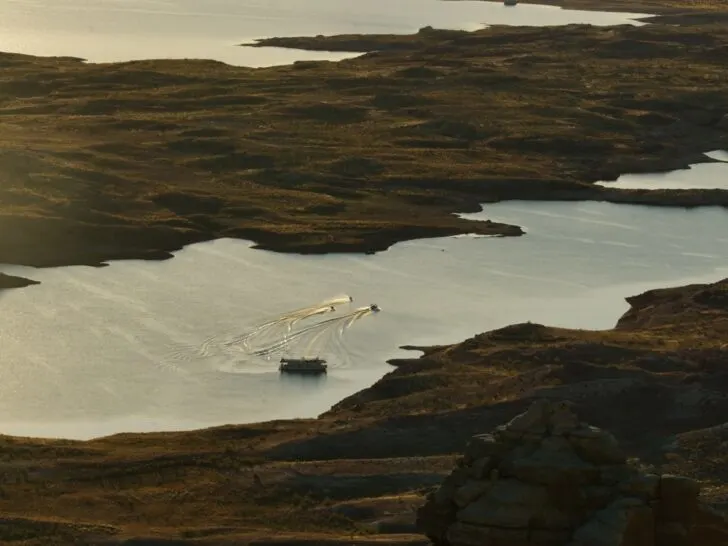
And also consider what options you have for getting your crew around the lake. Boat capacities are a key factor here.
If you have just one powerboat that holds 8 people, and your crew has 12 people, you won’t be able to take everyone simultaneously. This is a somewhat limiting factor especially if you are trying to do or see something as a group.
Otherwise, it’s beneficial to have your houseboat in close proximity to where you’re trying to go. And then people can take turns exploring with the powerboat.
Moving the houseboat usually takes a decent amount of time and effort. My advice is that if you have a motivated and able-bodied crew, then perhaps setting anchors is no big deal. But if your crew struggled with anchoring, then maybe it’s best to stay put and explore with your smaller vessels.
Moving the houseboat can provide a change of scenery. And it’s a good way to move your entire group to a new area (albeit slowly).
I used to really be motivated by the change of scenery, but the more times I have visited the lake, the more prone I am to leaving the houseboat in one spot. If you have a powerboat or jet skis, that’s a much faster way to explore different parts of the lake.
I also find that the burden of moving the houseboat falls unequally on the people driving the boats and digging the anchor holes. So the days that I feel truly relaxed are when the houseboat doesn’t move.
Tips For Daily Life on Lake Powell
Sharing a houseboat with a large group is really fun, but it does require some organization to ensure that it’s not overflowing with people and gear.
So lastly, I want to share some tips for staying organized and enjoying the lake with a big group.
Organization
As I mentioned before, having people sleep on the roof of the houseboat and on the beach is one of the best ways to provide everyone with a comfortable spot for sleeping.
We also found it helpful to divide the bedrooms up for people to put their personal stuff in. It’s not necessarily where they will sleep, but just a room where they can change clothes or have a little personal space if needed.
Likewise, you should divide up the cabinet space in the kitchen/dining room area. That way people know exactly where to find their food, and it’s not all mixed together.
Then stack beer, water, and coolers as efficiently as you can in the corners of the kitchen/dining room area. The stack will get smaller as you consume it.
Keeping Tidy
The boat will get messy quickly with so many people sharing a small space.
So encourage everyone to tidy up daily, or multiple times a day. Try to get everyone in the habit of putting food and other things away after they are finished.
We found it helpful to have a Sharpie in the kitchen so people could label their drinks or whatever. This will help cut down on the number of “wounded soldiers”.
The boat comes with a broom and dust-pan, which are key for battling all the sand that is going to come into the cabin. You can try to minimize the amount of sand, but it’s coming in, so don’t worry too much.
Waste
Keeping your trash to a minimum starts before you even get on the boat. With everything you bring, consider how much space it will take up on the boat.
Small decisions when you are packing and buying supplies can make a big difference. So, like I mentioned before, try to avoid bringing cases of water bottles.
Don’t bring glass. Aluminum and plastic are not only lighter, but also can be crushed after you’re finished with them.
To make things easier, every boat comes with a can crusher mounted on the front deck. Crush everything you can, seriously, the trash will accumulate quickly.
When you’re deciding what foods to bring, consider the amount of waste they create. For example, say you wanted to have corn on the cob every night because it’s a cheap and delicious summer food. But now consider how many ears of corn you will have in your trash by the end of the trip.
While on the trip, I like to divide waste into three different categories. Trash, recycling, and burnables.
Burnables
Anything flammable like paper and cardboard can be collected in an empty beer box. Then when you have a campfire at night, simply burn the whole box.
It can help you get your fire going and will also help reduce your waste.
Recycling
Both marinas accept recycling. So dedicate a garbage bag or bin for aluminum, plastic, and glass. Do your best to crush any plastic and aluminum to save space.
Trash
Everything else can go into the trash. If you’ve planned efficiently, your total trash amounts should be pretty low. Once you fill up the trash can in the kitchen, tie it off and take it to the back deck. Every houseboat comes with a standard trash barrel and lid. You want to save this space strictly for trash bags. You can leave your bags of recycling sitting out next to the trash barrel.
Pest Control
They recommend using aluminum pie pans to stop mice from using your anchor lines to board your houseboat. Cut a slit into the center of the pans and then slide them onto your anchor lines. Admittedly, we’ve never done this because it isn’t always necessary.
A few easy steps to take against mice are keeping the lid of your trash barrel closed at all times and keeping the doors to your houseboat shut at night.
They may try to get into your recycling, but it will be much less of a problem than if they get into your trash.
We had mice chew up our recycling bags a little bit this past year, but finding mostly aluminum cans, they probably gave up.
Plus, they can only really do it at night, because during the day there is far too much activity for them to hang around.
The other pest we’ve encountered are flies. They’re small flies that thankfully don’t bite, but they can show up in overwhelming numbers. Especially around dusk and after dark.
We tried our best to keep the houseboat doors closed after dark, but it was pretty futile. The flies inevitably got in by the hundreds, maybe thousands. They are attracted to light, and mostly just swarm any lights that are on inside your houseboat.
So it’s definitely a good idea to keep bedroom doors closed and lights off.
But this has only been a problem for us certain years.
Electricity
You charge the houseboat batteries using the gas-powered generator on the back deck. Then use the breakers to provide power to different parts of the houseboat.
This breaker control panel is divided into two sections, battery power and generator power.
While the generator is running, you can power electricity via the generator. But also, the generator charges the houseboat batteries, which can be used when the generator is off.
It’s good to only use what you need to conserve power. We have found that running the generator for about 2 hours per day covers all our electricity needs.
We used electricity for lights, phones, cameras, coffee maker, microwave, and probably a few other things I’m forgetting.
Toilets
The toilet(s) on the houseboat are pretty simple to use (but not like a normal toilet).
There’s an electric pump that uses lake water to fill the toilets. Depress the foot pedal to flush the contents.
After the bowl has been cleared, lift up on the foot pedal to refill the toilet bowl. The water in the bowl ensures the toilet is ready for another use, and it prevents smells from coming up from the black water tank.
You also will be supplied with a water treatment solution. You should follow the instructions on the bottle and flush the solution into the black water tanks daily. This is another critical step for preventing odors.
There are black water pump out stations around the lake.
We have never personally used them. But certain years, there have definitely been some foul smells coming from the black water tanks into the houseboat.
Conclusion | Lake Powell Houseboating Trip
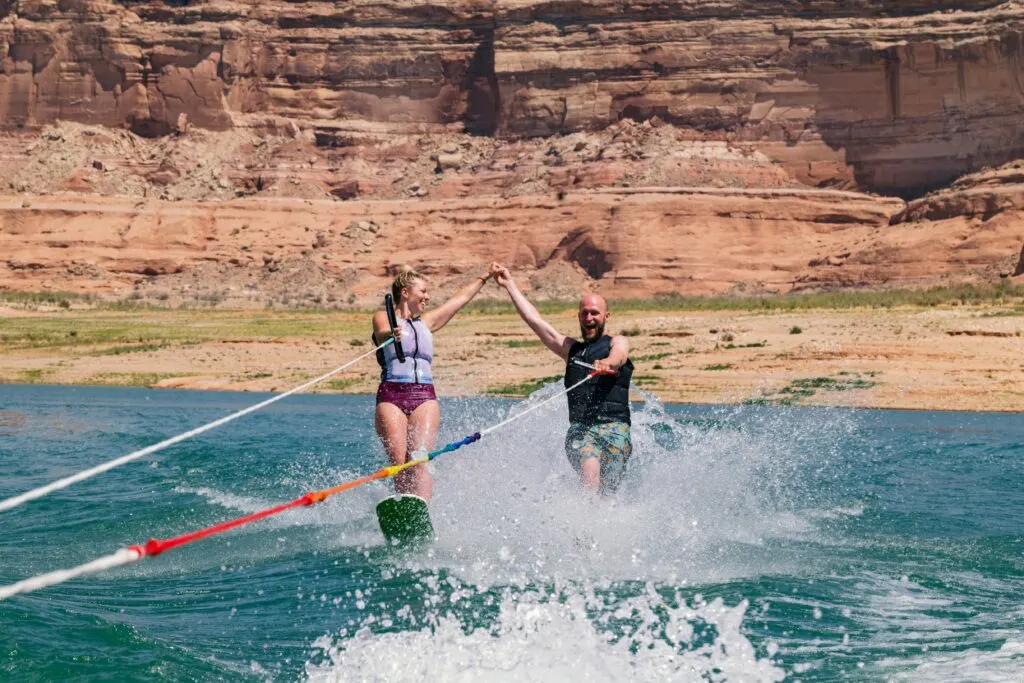
Despite all the traveling Emily and I have done, Lake Powell Houseboat Trips remain our favorite vacation.
There is just no feeling quite like exploring the remote desert with a boat loaded with friends and family. The adventures, scenery, and memories are very hard to beat!
So we really wanted to share all we know so that you can pull off this amazing trip for yourself.
If you missed other parts of this guide, be sure to check out Part 1 and Part 2.
- Part 1: How To Plan A Lake Powell Houseboat Trip: Assemble Your Crew, Book A Houseboat Reservation
- Part 2: What To Bring On A Lake Powell Houseboat Trip & Preparing For Departure.
If you are planning a trip to the area, we have some other guides to our favorite spots.
Share This ‘Lake Powell Houseboat Guide Series’ On Pinterest!
